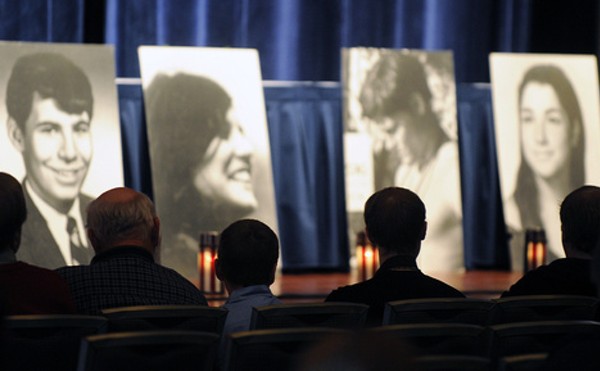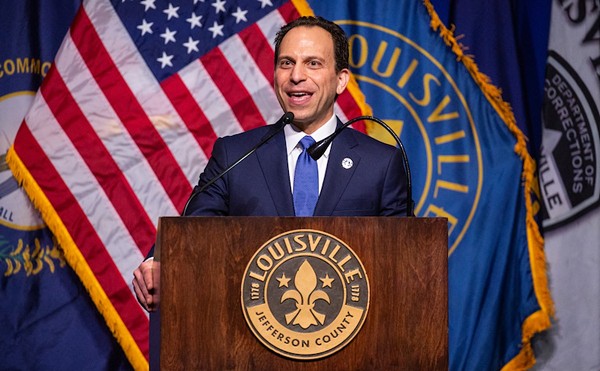to present a picture of Iraq that other media haven’t shown
[img_assist|nid=3623|title=A child plays|desc=PHOTO BY MOLLY BINGHAM/WORLDPICTURENEWS BAGHDAD (ADHAMIYA), Nov. 24, 2003 — A child plays on a main street in Adhamiya where a poster hangs on a lamp post seeking Muhammed Saddam, formerly a policeman and now accused of working with the Americans. (Graff|link=|align=left|width=200|height=134]On the final Saturday of 2006, Molly Bingham and Steve Connors learned of the hanging of Saddam Hussein in Baghdad for the 1982 killings of 148 men and boys in the northern town of Dujail. Like most days, and especially when there are such major developments, the two pored over the latest media reports in their Washington, D.C., home. She typically scrutinizes stories in the mainstream press while he peruses the latest blog postings on sites dedicated to furthering understanding of events in Iraq.
Bingham, a photographer and the youngest daughter of Louisville’s late media magnate, Barry Bingham Jr., was stunned by The New York Times’ coverage of the event.
“
They have lively discussions almost every morning when they compare notes on the day’s reports. The overriding goal is to decipher what is happening on the ground in Iraq, and it’s an extension of their experiences covering the war-torn country in 2003 and 2004, which included the making of a documentary called “Meeting Resistance.” These first-time directors are in the final phase of editing the film, which is now running 82 minutes. They hope to find a distributor and get the film accepted by a film festival this spring to get their story to the public.
“Meeting Resistance” grew out of three trips to Iraq between March 17, 2003, and May 31, 2004. Seven days after her first arrival, Bingham was arrested by Saddam’s forces and held at Abu Ghraib prison for eight days. Undaunted, she returned that April and stayed through June, taking photographs on assignment for various publications. (Twenty-two Bingham photographs go on display Monday at the Actors Theatre Gallery. They’re up through Feb. 4 in conjunction with ATL’s staging of Heather Raffo’s one-woman show, “9 Parts of Desire,” in which the actress portrays a diverse selection of Iraqi women. Raffo wrote the script based on interviews conducted during a trip to her father’s home country.)
[img_assist|nid=3624|title=searching for her son|desc=PHOTO BY MOLLY BINGHAM/WORLDPICTURENEWS HILLA, IRAQ, May 24, 2003 — Bingham took this photo, which will be on exhibit at Actors Theatre, after Saddam was overthrown in 2003 and dozens of mass graves were excavated, disgorging the remains of many Iraqis k|link=|align=right|width=200|height=130]Also during that period, Bingham teamed with Connors, a freelance photographer she met in Afghanistan in 2001. By June 2003 they both began to notice and question the nature of the emerging attacks on Coalition troops, which increased over that summer. Connors, who was born in Sheffield, England, had served as a British soldier in Northern Ireland in the early 1980s. He noted that the attacks were amateurish. “They were sort of hit and run attacks where advantages were never pressed, so essentially these were not military operations as such,” he says. “They were just too haphazard.”
They also discussed their journalistic goals. Bingham has covered conflict and human rights issues in Rwanda, Burundi and the Democratic Republic of Congo for Human Rights Watch and publications including The New York Times Sunday Magazine. She wanted to write. Connors has photographed 10 conflicts for various publications including Time, Newsweek, The New York Times, The Guardian and The Observer. He wanted to make a documentary.
During the summer of 2003, they decided to focus their reporting on Baghdad’s Adhamiya neighborhood, where Bingham, while on a freelance assignment that May, had met a man who told her he was in a resistance movement.
“That meeting 
The two came to the United States to organize themselves for their new projects and planned to return to Baghdad in August 2003. The photographers were hearing U.S. government officials and media refer to these resistors as hooligans, dead-enders and former members of Saddam’s Baath party. Maybe that was accurate, they say, but they were skeptical and wanted to travel to Iraq and find out for themselves.
Bingham says they had no preconceptions about the identities of these people, but they did have questions: “So what is the other side? Who are these people? What do they believe in? What’s going on? What do they think they are going to accomplish?”
“We felt,” she adds, “that that was just a very fundamental, really basic, sort of journalistic curiosity that had to be addressed, and we didn’t see anybody doing it.”
In an effort to locate the resistors, the journalists discussed living in Adhamiya, a tempting but unrealistic option.
“As great as it would be to get closer to this community and really understand and get inside it more, it was too dangerous,” Bingham says.
Connors believes the couple’s constant presence in the neighborhood would have attracted the attention of the American military and possibly jeopardized their lives — they could have been perceived and treated as traitors by their sources.
[img_assist|nid=3625|title=Sha’ad Mehdi|desc=PHOTO BY MOLLY BINGHAM/WORLDPICTURENEWS BAGHDAD, Oct. 27, 2003 — In this photo by Bingham, which Actors Theatre will display, Sha’ad Mehdi, 47, holds shrapnel from an explosion at a police station that shattered every window in his house more than a bloc|link=|align=left|width=200|height=130]So they lived at the Hamra hotel in Baghdad’s Jadriya neighborhood and visited Adhamiya daily, hanging out in teashops, drinking tea, smoking cigarettes, playing backgammon and trying to cultivate relationships with locals. In time, Bingham says, she became reacquainted with the man whom she’d met earlier that year and who had claimed to be in the resistance. Later, they say, they met and interviewed other people involved in attacks or logistics for the resistance.
Based on conversations with resistors and the other people they met there, Bingham says, they found an Iraqi resistance that had passive public support mixed with active public support — that is, people involved in attacks and moving weapons.
Rank and file resistors did not fit any particular profile, but most had one common characteristic: They found it absurd that the mainstream media described them as members of Al Qaeda or the former Baath party. Instead, Bingham and Connors say, they learned that these people, who became known as insurgents, were motivated by a mix of nationalism and interpretations of Islam that, in the Iraqis’ current situation, mandated jihad.
Ultimately, the pair interviewed 12 people, 10 of whom are in the film. Of those, interviews with three — whom the filmmakers name only as “the teacher,” “the warrior” and “the traveler” — provided the narratives that Bingham says bridge the entire film. (Bingham wrote a story called “Ordinary Warriors” for Vanity Fair, published in 2004, in which “the teacher” is a major source.) During the 10-month process of shooting the film, the two say they watched these people hone their combat skills and logistics by improving coordination and how they supplied themselves. Connors says the sources spoke with the couple because they wanted their story and history to be told.

“There wasn’t that much trust,”
Connors says.
When the pair digested what they’d captured on film, their conclusions about the insurgency in Iraq differed significantly from those of other journalists. However, their story didn’t raise much enthusiasm when they pitched it to network TV in 2004 and 2005.
“We were banging our heads against a wall that we couldn’t really see,” Connors says.
Based on their experiences and how they differed from what they were seeing in media reports, they began to question the actions and intentions of the press more than they ever had. Bingham gave a speech in April 2005 at Western Kentucky University in which she said her experience taught her that “many journalists in Iraq could not, or would not, check their nationality or their own perspective at the door”; that “(seeking) to understand and present to an American audience the reason behind the Iraqi opposition is practically treasonous”; and that gatekeepers, including editors, publishers and media company business sides, don’t want “their outlet to reveal that compelling narrative of why anyone would oppose the presence of American troops on their soil.”
Soon after, The Courier-Journal ran the text of the speech in its op-ed section, then received an assortment of letters both denouncing and extolling her views.

Last summer and early fall, they edited further and held eight small, private screenings for audiences with varied backgrounds, including the general public, Iraq war veterans, retired and active intelligence experts and professionals working at the Pentagon. It was shown in Washington, D.C., New York and London and at the University of Kentucky School of Journalism. They got positive feedback and audience members felt prompted to ask questions. Several people, Connors says, remarked, “I have different questions now, different questions from the ones I had before.”
Constructive criticism said the directors needed to include more context — information about Iraq’s history, Islam and some of the main actors in the conflict, such as Grand Ayatollah Ali al-Sistani and Abu Musab al-Zarqawi.
Throughout this process, they’ve kept the documentary focused on their main objective, which Bingham describes as informing the dialogue about who the United States is fighting in Iraq so it can determine how to most effectively create peace in Iraq. She also is quick to say the film does not aim to promote a specific point of view like “Fahrenheit 9/11.”
“We’ve actually gone way out of our way not to make this a polemic film,” she says. “This film does not discuss the political decisions that were made in Washington except as the characters themselves discuss them or raise them.”
Meanwhile, the couple hopes to have a world premiere of “Meeting Resistance” at a film festival sometime this year. (They have applied to several festivals scheduled this February through May.) If the film doesn’t make a festival cut, they will continue efforts to find a distributor.
“It will be released, one way or another, this year,” Connors pledges. “That is for sure.”
Bingham interjects. “We’re looking for somebody who’s willing to step forward and put out this narrative that is not one that Americans have seen,” she says, adding that she really wants to have a big event for a Louisville showing. “That could be as early as this spring.”
Throughout the project, Bingham and Connors have maintained a romantic relationship that began in May 2003; soon after the two knew they also wanted to work together. This, of course, has posed its own challenges.
Bingham explains that, “Steve and I have very different —”
“Styles,” Connors interjects.
The rewards, they say, have included completing a project that allows both to use specific skills, knowledge and prior experiences. But would they take on a similar project again? They laugh for a long time at this question.
Finally, Bingham responds. “The great part is that we do really get each other’s profound journalistic motivations and visions, which we share on a very deep level,” she says. “This is this tremendously important time in American history. Let’s put Iraqi history aside. But the impact that this is having on America as a country and both our own role in the world and our experience of ourselves as Americans; this is having a profound impact on that. And I think it’s something that everyone should sort of sit up and pay some attention to, and we hope that our film can help that happen.”
Contact the writer at [email protected]





